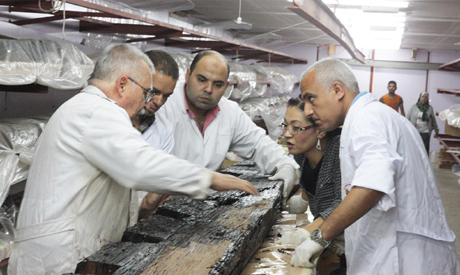Excavation of King Khufu’s Second Solar Boat Completed in Egypt
Ahram Online reports that the excavation of the second Khufu solar boat discovered in a pit next to the Great Pyramid of Khufu in 1954 has been completed by a joint Japanese and Egyptian team of researchers.
Sakuji Yoshimura, the head of the Egyptian Japanese archaeological mission and president of Higashi Nippon International University, and Professor Emeritus of Waseda University have completed the excavation of the second Khufu Boat from the pit in which it was discovered beside Khufu pyramid in the Giza plateau.
Issa Zidan, the director-general of executive affairs for restoration at the Grand Egyptian Museum and the supervisor of the restoration work of the second Khufu Boat, explained that nearly 1,700 wooden pieces were extracted from 13 layers inside the pit, noting that the registration and documentation of all pieces have been done, as well as the initial restoration of most of these pieces was completed.

He also added that, so far, 1,343 pieces were transferred to the Grand Egyptian Museum, where preparations are underway for starting the second phase that includes the final restoration work, as well as conducting the necessary studies for assembling and re-installing the boat that will be displayed next to the first one inside the new building dedicated for King Khufu’s boats, which is now being constructed at the Grand Egyptian Museum.
Omura Yoshifumi, the chief representative of the Japan International Cooperation Agency (JICA) Egypt Office, said that the JICA will provide a $3 million grant for completion of the final restoration work and reassembly of the boat for its display in the museum, in addition to the $2 million grant that was provided in 2013, which supported the excavation and extracting process of the wooden pieces of the boat from the pit.
The project of restoring and extracting the wooden pieces of the second Khufu Boat is one of the largest restoration projects that represent the aspects of fruitful cooperation between Egypt and Japan, with the support of the JICA.
Cooperation between Egyptians and the Japanese in the Grand Egyptian Museum project started in 2006, when the JICA provided financial support through two soft loans of official development assistance for the construction of the museum at the request of the Egyptian government.
Since 2008, the JICA has been providing technical cooperation through the Egyptian Japanese joint conservation project for the restoration, documentation, packaging, and transfer of 72 artefacts — among which were some of King Tutankhamun’s collection — from the Egyptian Museum in Tahrir and other sites to the Grand Egyptian Museum.
About 90 Japanese experts participated in this project, and a number of high-tech technical equipment were provided within the project, such as a digital microscope, a portable X-ray machine, and an electric forklift to carry heavy artefacts safely.
Ambassador Noke expressed his appreciation for the fruitful cooperation with the Ministry of Tourism and Antiquities led by Minister of Tourism and Antiquities Khaled El-Enany and the sincere efforts of Major-General Atef Moftah — the general director of the Grand Egyptian Museum project — and the surrounding area to realise all this progress, stressing that the Grand Egyptian Museum is a symbol of Egyptian Japanese friendship.
From his side, Yoshifumi expressed appreciation for the Egyptian government’s strong leadership in making such great progress in the Grand Egyptian Museum’s construction and related works towards its opening, emphasising that he is proud that the JICA takes part in preserving the world’s treasures in Egypt to the future generations through this project.





